load capacity AUDI S8 2012 Owners Manual
[x] Cancel search | Manufacturer: AUDI, Model Year: 2012, Model line: S8, Model: AUDI S8 2012Pages: 300, PDF Size: 75.06 MB
Page 71 of 300
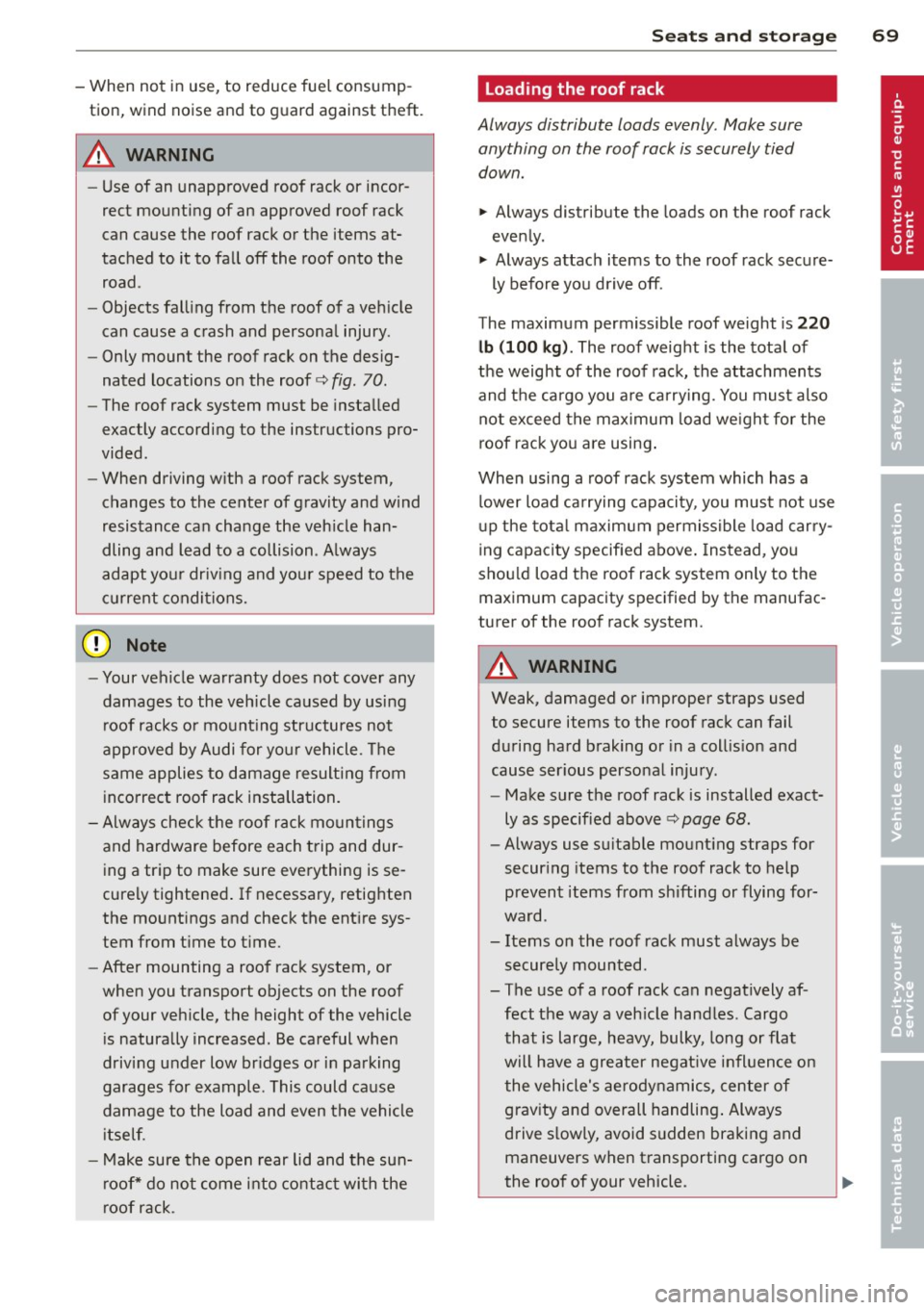
-When not in use, to reduce fuel consumpĀ
tion, wind noise and to guard against theft.
A WARNING
- Use of an unapproved roof rack or incorĀ
rect mounting of an approved roof rack
can cause the roof rack or the items atĀ
tached to it to fall off the roof onto the
road .
- Objects falling from the roof of a veh icle
can cause a crash and personal injury .
- Only mount the roof rack on the desigĀ
nated locations on the roof
c::> fig . 70 .
-The roof rack system must be installed
exactly according to the instructions proĀ
vided.
- When driving w ith a roof rack system,
changes to the center of gravity and wind
resistance can change the veh icle hanĀ
dling and lead to a collision . Always
adapt your driv ing and your speed to the
current conditions.
0 Not e
-Your vehicle warranty does not cover any
damages to the vehicle caused by using
r oof racks or mount ing structures not
approved by Audi for your vehicle. The
same applies to damage resulting from
incorrect roof rack installation.
- Always check the roof rack mountings
and hardware before each trip and durĀ
ing a trip to make sure everything is seĀ
cure ly tightened . If necessary, retighten
the mount ings and check the ent ire sysĀ
tem from t ime to t ime.
- After mounting a roof rack system, or
when you transport objects on the roof
of your veh icle, the height of the vehicle
i s naturally increased. Be careful when
driv ing under low br idges or in parking
garages for example. This could cause
damage to the load and even the vehicle
i tself.
- Make sure the open rear lid and the sunĀ
roof* do not come into contac t with the
roof rack .
Seat s an d sto rage 69
Loading the roof rack
Always distribute loads evenly. Make sure
anything on the roof rack is securely tied
down .
.. Always distribute the loads on the roof rack
even ly .
.. Always attach items to the roof rack secure-
ly before you d rive off .
The maximum permissible roof weight is
2 20
lb (100 kg ).
The roof weight is the total of
the weight of the roof rack, the attachments
and the cargo you a re carrying. You must also
not exceed the maximum load we ight for the
roof rack you are using .
When using a roof rack system which has a l ower load ca rrying capaci ty , you must not use
up the tota l maxim um permissible load car ry Ā
i ng capacity specified above . Instead, you
sho uld load the roof rack system only to the
maximum capacity specified by the manufac Ā
turer of the roof rack system.
A WARNING
---Weak, damaged or improper straps used
to secure items to the roof rack can fail
during hard braking or in a collis ion and
cause ser ious personal injury.
- Make sure the roof rack is installed exactĀ
ly as specified above
c::> page 68.
-Always use su itable mount ing straps for
securing items to the roof rack to help
p revent items from sh ifting or flying forĀ
ward.
- Items on the roof rack must always be
securely mounted.
- The use of a roof rack can negat ively afĀ
fect the way a veh icle hand les . Cargo
that is large, heavy, bulky, long or flat
will have a greater negat ive influence on
the vehicle's aerodynamics, center of gravity and overall handling . Always
drive s lowly, avoid sudden braking and
maneuvers when transporting cargo on
the roof of your vehicle .
Page 72 of 300
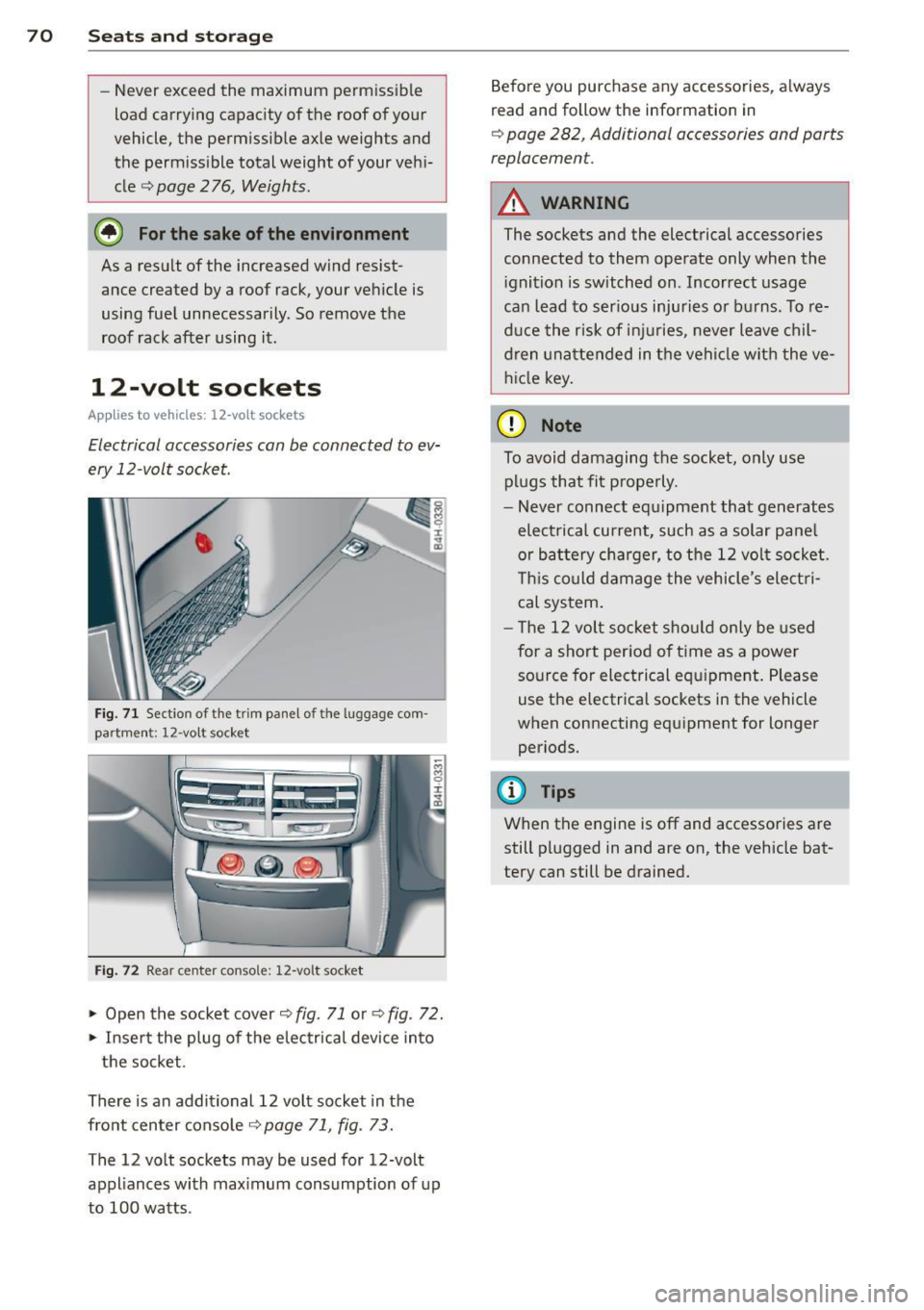
70 Seats and storage
-Never exceed the maximum permissible
load carrying capacity of the roof of your
vehicle, the permissible axle weights and
the permissible total weight of your vehiĀ cle
c::, page 276, Weights .
@ For the sake of the environment
As a result of the increased wind resistĀ
ance created by a roof rack, your vehicle is
using fuel unnecessarily. So remove the
roof rack after using it.
12-volt sockets
Applies to vehicles: 12-volt soc kets
Electrical accessories can be connected to evĀ
ery 12-volt socket.
Fig. 71 Sect io n of the trim panel of th e lu ggage comĀ
part ment: 12 -vol t soc ket
Fig. 72 Rear center conso le: 12-vo lt soc ket
... Open the socket cover c::, fig. 71 or c::, fig. 72 .
... Insert the plug of the electrical device into
the socket.
There is an additional 12 volt socket in the
front center console~
page 71, fig. 73.
The 12 volt sockets may be used for 12-volt
appliances with maximum consumption of up
to 100 watts . Before you purchase any accessories, always
read and follow
the information in
c::, page 282, Additional accessories and parts
replacemen t.
A WARNING
The sockets and the electrical accessories
connected to them operate only when the ignition is switched on . Incorrect usage
can lead to serious injuries or burns. To reĀ
duce the risk of injuries , never leave chilĀ
dren unattended in the vehicle with the veĀ
hicle key.
(D Note
To avoid damaging the socket, only use plugs that fit properly.
- Never connect equipment that generates
electrical current, such as a solar panel
or battery charger, to the 12 volt socket .
This could damage the vehicle 's electriĀ
cal system.
- The 12 volt socket should only be used
for a short period of ti me as a power
source for electrical equipment. Please
use the electrical sockets in the vehicle
when connecting equipment for longer periods.
@ Tips
When the engine is off and accessories are
still plugged in and are on, the vehicle batĀ
tery can still be drained.
Page 75 of 300
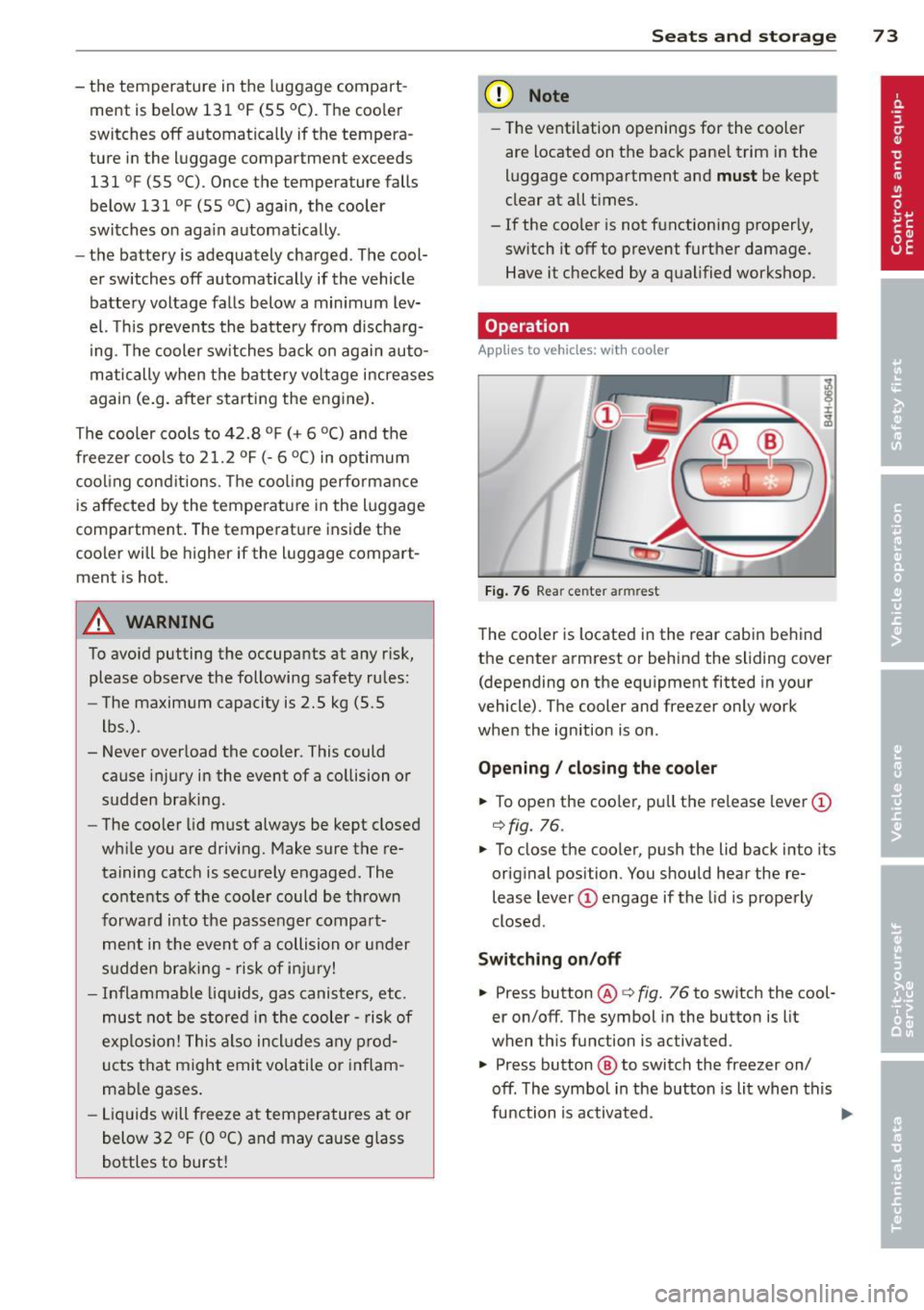
- the temperature in the luggage compartĀ
ment is below 131 Ā°f (55 Ā°C). The cooler
switches off automatically if the temperaĀ
ture in the luggage compartment exceeds
131 Ā°f (55 Ā°C) . Once the temperature falls
below 131 Ā°f (55 Ā°C) again, the cooler
switches on aga in automatically .
- the battery is adequately charged . The coolĀ
er switches off automatically if the vehicle
battery voltage falls below a minimum levĀ
el. This prevents the battery from discha rgĀ
i ng . The cooler switches back on again autoĀ
matically when the battery voltage increases
again (e.g . after starting the engine).
The cooler cools to 42.8 Ā°f
(+ 6 Ā°C) and the
freezer cools to 21.2 Ā°f (-6 Ā°C) in opt imum
cooling cond itions . Th e cooling performance
is affected by the temperature in the luggage
compartment. The temperature inside the
cooler will be higher if the luggage compartĀ
ment is hot.
A WARNING
To avoid putting the occupants at any risk,
please observe the following safety rules:
- The maximum capacity is 2.5 kg (5.5
lbs.).
- Never overload the cooler. This could
cause injury in the event of a collision or
sudden braking.
- The coo ler lid must always be kept closed
while you are driving. Make sure the reĀ
taining catch is securely engaged. The
contents of the coo ler could be thrown
forward into the passenger compartĀ
ment in the event of a collision or under
sudden braking - risk of injury!
- Inflammable liquids, gas canisters, etc.
must not be stored in the cooler -risk of
exp losion! This also includes any prodĀ
ucts that might emit volatile or inflamĀ
mable gases.
- Liquids will freeze at temperatures at or
below 32 Ā°f (0 Ā°C) and may cause glass
bottles to burst!
Seats and storage 73
(D Note
-The venti lation openings for the cooler
are located on the back pane l trim in the
luggage compartment and
must be kept
clear at all t imes.
- If the cooler is not functioning properly,
switch it off to prevent further damage.
Have it checked by a qualified workshop .
Operation
Applies to vehicles: wit h coo ler
Fig. 76 Rea r ce nte r armre st
The cooler is located in the rear cabin behind
the center armrest or behind the sliding cover (depending on the equipment fitted in your
vehicle) . The cooler and freezer only work
when the ignition is on .
Opening / closing the cooler
.,. To open the cooler, pull the release lever@
~ fig. 76.
.,. To close the cooler, push the lid back into its
original position. You should hear the reĀ
lease lever
(D engage if the lid is properly
closed.
Switching on /off
.,. Press button @ 9 fig. 76 to sw itch the coolĀ
er on/off. The symbol in the button is lit
when this function is activated .
.,. Press button
@ to switch the freezer on/
off . The symbol in the button is lit when this
function is activated .
Page 133 of 300

-Always distribute the load as evenly as
possible.
- Place heavy objects as far forward in
the luggage compartment as possible.
- Never exceed the Gross Axle Weight RatĀ
ing or the Gross Vehicle Weight Rating
specified on the safety compliance stickĀ
er on the left door jamb. Exceeding perĀ
missible weight standards can cause the
vehicle to slide and handle differently .
- Please observe information on safe drivĀ
ing
o page 124 .
A WARNING
-
To help prevent poisonous exhaust gas
from being drawn into the vehicle, always
keep the rear lid closed while driving .
- Never transport objects larger than those fitting completely into the luggage
area because the rear lid cannot be fully
closed.
- If you absolutely must drive with the rear
lid open, observe the following notes to
reduce the risk of poisoning:
-Close all windows,
- Close the power roof,
- Open all air outlets in the instrument
panel,
- Switch off the air recirculation,
- Set the fresh air fan to the highest
speed.
A WARNING
Always make sure that the doors, all winĀ dows, the power roof and the rear lid are
securely closed and locked to reduce the
risk of injury when the vehicle is not being
used .
- After closing the rear lid, always make
sure that it is properly closed and locked.
- Never leave your vehicle unattended esĀ pecially with the rear lid left open. A
child could crawl into the vehicle through
the luggage compartment and close the
rear lid becoming trapped and unable to
get out . Being trapped in a vehicle can
lead to serious personal injury .
-
Driving Safely 131
-Never let children play in or around the
vehicle.
- Never let passengers ride in the luggage
compartment. Vehicle occupants must
always be properly restrained in one of
the vehicle's seating positions .
(D Tips
-Air circulation helps to reduce window
fogging. Stale air escapes to the outside
through vents in the trim panel, on the
left side of the luggage compartment. Be sure to keep these slots free and
open .
- The tire pressure must correspond to the
load . The tire pressure is shown on the
tire pressure label. The tire pressure laĀ
bel is located on the driver's side B-pillar.
The tire pressure label lists the recomĀ
mended cold tire inflation pressures for
the vehicle at its maximum capacity
weight and the tires that were on your
vehicle at the time it was manufactured.
For recommended tire pressures for norĀ
mal load conditions, please see chapter
opage 239.
Tie-downs
The luggage compartmen t is equipped with
four tie-downs to secure luggage and o ther
items .
Use the tie-downs to secure your cargo propĀ
erly
o page 130, Loading the luggage comĀ
partment .
In a collision , the laws of physics mean that
even smaller items that are loose in the vehiĀ
cle will become heavy missiles that can cause
serious injury. Items in the vehicle posses s en Ā
ergy which vary with vehicle speed and the
weight of the item. Vehicle speed is the most
significant factor.
For example, in a frontal collision at a speed
of 30 mph (48 km/h), the forces acting on a
10-lb (4 .5 kg) object are about 20 times the
normal weight of the item . This means that
the weight of the item would suddenly be
ā¢
ā¢
Page 189 of 300
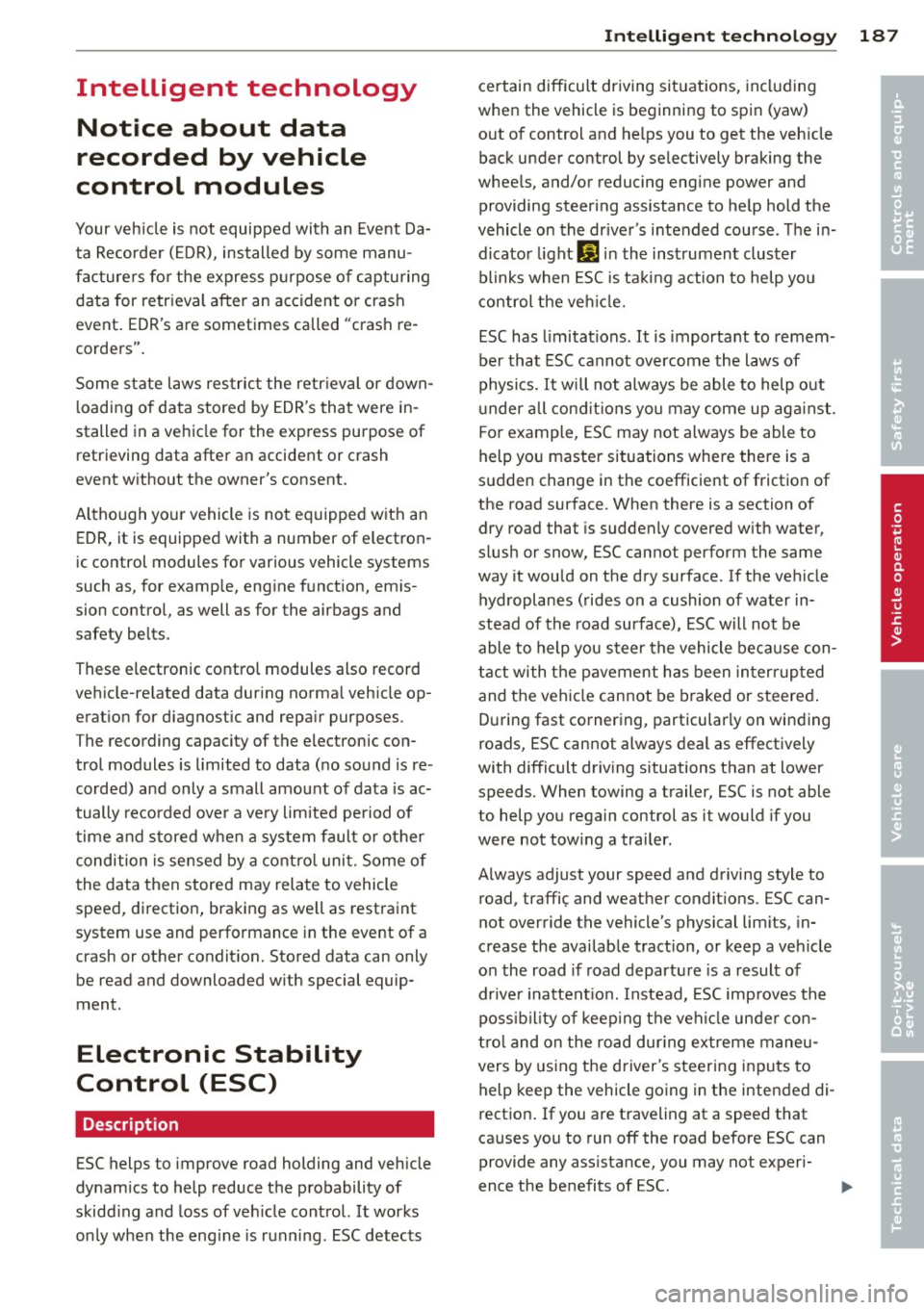
Intelligent technology Notice about data
recorded by vehicle
control modules
Your vehicle is not equipped with an Event DaĀ
ta Recorder (EDR), installed by some manuĀ
facturers for the express purpose of capturing
data for retrieval after an accident or crash
event. EDR's are sometimes called "crash reĀ
corders".
Some state laws restrict the retr ieval or downĀ
loading of data stored by EDR's that were inĀ
stalled in a vehicle for the express purpose of
retrieving data after an accident or crash
event without the owner's consent.
Although your vehicle is not equipped with an
EDR, it is equipped with a number of electronĀ
ic control modules for various vehicle systems
such as, for examp le, engine function, emisĀ
sion control, as well as for the airbags and
safety belts.
These electronic control modules also record
vehicle-related data during norma l vehicle opĀ
eration for diagnostic and repair purposes.
The recording capacity of the electronic conĀ
trol modules is limited to data (no sound is reĀ
corded) and only a small amount of data is acĀ
tually recorded over a very limited period of
time and stored when a system fault or other
condition is sensed by a control unit. Some of
the data then stored may relate to vehicle
speed, direction, braking as we ll as restraint
system use and performance in the event of a
crash or other condition. Stored data can only be read and downloaded with special equipĀ
ment.
Electronic Stability
Control (ESC)
Description
ESC helps to improve road holding and vehicle
dynamics to help reduce the probability of
skidding and loss of veh icle control. It works
only when the engine is running. ESC detects
Intelligent technology 187
certain difficult driving situations, including
when the vehicle is beginning to spin (yaw)
out of control and helps you to get the veh icle
back under control by se lectively braking the
wheels, and/or reducing engine power and
providing steering ass istance to help hold the
vehicle on the driver's intended course. The inĀ
dicator light
Ip.] in the instrument cluster
blinks when ESC is taking action to help you
control the vehicle.
ESC has limitations .
It is important to rememĀ
ber that ESC cannot overcome the laws of
physics.
It will not always be able to help out
under all conditions you may come up against.
For example, ESC may not always be able to
help you master situations where there is a
sudden change in the coefficient of friction of
the road surface. When there is a section of
dry road that is suddenly covered with water,
slush or snow, ESC cannot perform the same
way it would on the dry surface . If the vehicle
hydroplanes (rides on a cushion of water inĀ
stead of the road surface), ESC will not be
able to help you steer the vehicle because conĀ
tact with the pavement has been interrupted
and the vehicle cannot be braked or steered .
During fast cornering, particularly on winding
roads, ESC cannot always deal as effectively
with difficult driving situations than at lower
speeds. When towing a trailer, ESC is not able
to help you regain control as it would if you
were not tow ing a trailer.
Always adjust your speed and driving style to road, traffi<; and weather conditions. ESC canĀ
not override the vehicle's physical limits, inĀ
crease the available traction, or keep a veh icle
on the road if road departure is a result of
driver inattention. Instead, ESC improves the
poss ibility of keeping the vehicle under conĀ
trol and on the road dur ing extreme maneuĀ
vers by using the driver's steering inputs to
help keep the vehicle going in the intended diĀ
rection. If you are traveling at a speed that
causes you to run off the road before ESC can
provide any assistance, you may not experiĀ
ence the benefits of ESC.
ā¢
ā¢
Page 238 of 300
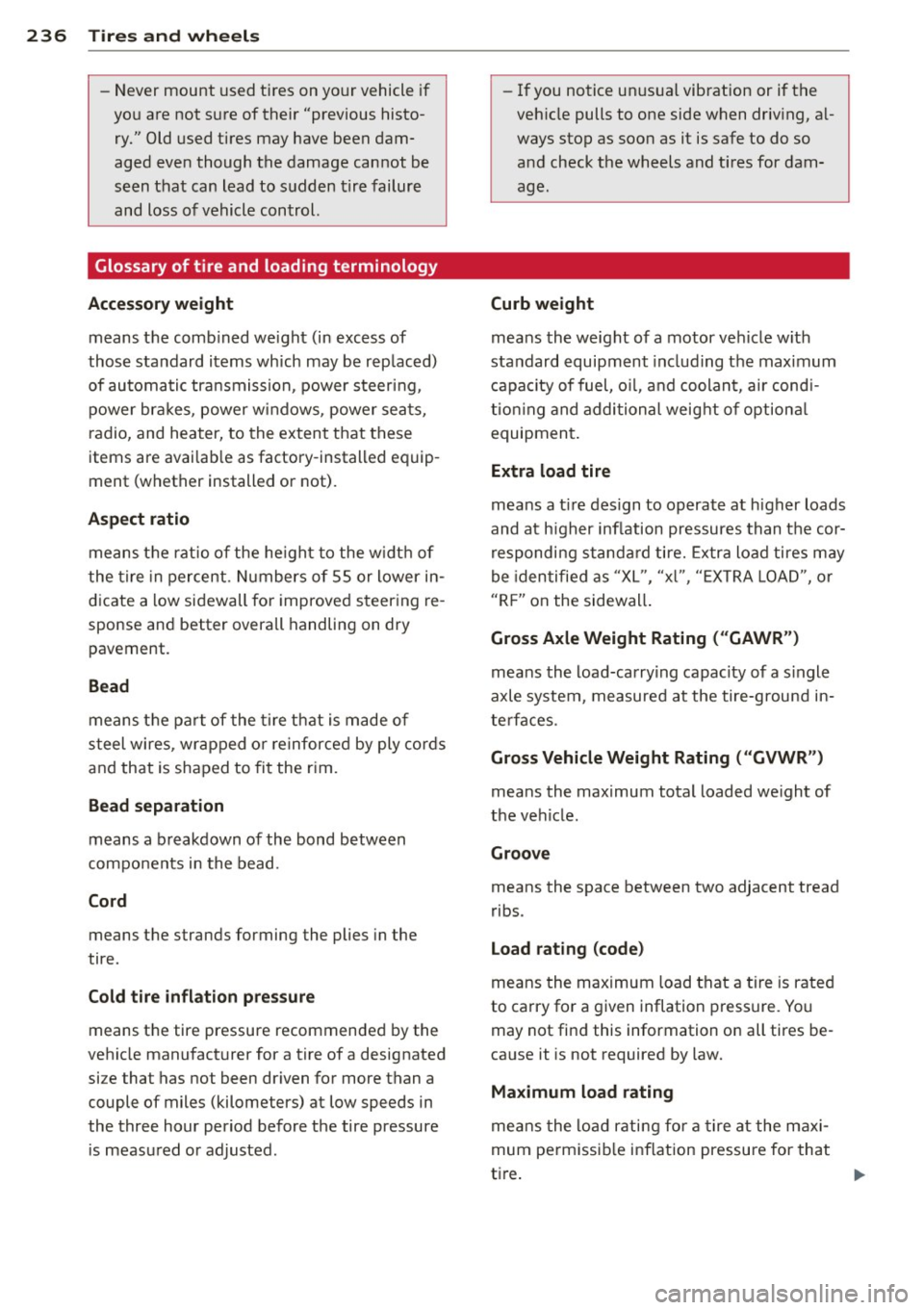
236 Tires and wheels
-Never mount used tires on yo ur vehicle if
you are not sure of their "previous histoĀ
ry." Old used tires may have been damĀ
aged even though the damage cannot be
seen that can lead to sudden tire failure
and loss of vehicle control.
Glossary of tire and loading terminology
Accessory weight
means the comb ined weight (in excess of
those standard items which may be rep laced)
of automatic transmission, power steering, power brakes, power windows, power seats,
radio, and heater, to the extent that these
items are availab le as factory -installed equip Ā
ment (whether installed or not) .
Aspect ratio
means the ratio of the he ight to the w idth of
the tire in percent. Numbers of 55 or lower inĀ
dicate a low sidewall for improved steering reĀ
sponse and better overall handling on dry
pavement.
Bead
means the part of the tire that is made of
steel wires, wrapped o r reinforced by ply cords
and that is shaped to fit the r im.
Bead separation
means a breakdown of the bond between
components in the bead.
Cord
means the strands forming the plies in the
tire.
Cold tire inflation pressure
means the tire pressure recommended by the
vehicle manufacturer for a tire of a designated size that has not been driven for more than a
couple of miles (kilometers) at low speeds in
the three hour period before the tire pressure
is measured or adjusted. -
If you notice unusual vibration or if the
veh icle pulls to one side when driv ing, a lĀ
ways stop as soon as it is safe to do so and check the wheels and tires for damĀ
age.
Curb weight
means the weight of a motor vehicle w ith
standard equipment including the maximum
capacity of fuel, oil, and coolant, air condiĀ
tioning and additional weight of optiona l
equipment.
Extra load tire
means a t ire design to operate at h igher loads
and at higher inflation pressures than the corĀ
responding standard tire. Extra load tires may
be identified as "XL", "xl", "EXTRA LOAD", or
"R F" on the sidewall .
Gross Axle Weight Rating ( "GAWR ")
means the load-carrying capacity of a s ingle
axle system, measured at the tire-ground inĀ
terfaces .
Gross Vehicle Weight Rating ("GVWR")
means the maximum total loaded weight of
the vehicle.
Groove
means the space between two adjacent tread
ribs .
Load rating (code)
means the maximum load that a tire is rated
to carry for a given inflation pressure. Yo u
may not find this information on all tires beĀ
cause it is not required by law.
Maximum load rating
means the load rating for a tire at the maxiĀ
mum permissib le inflation pressure for that
tire.
Page 239 of 300

Maximum loaded vehicle weight
means the sum of:
(a) Curb weight
(b) Accessory weight
(c) Vehicle capacity weight, and
(d) Production options weight
Maximum (permissible) inflation pressure
means the maximum cold inflation pressure
to which a tire may be inflated. Also called
"maximum inflation pressu re."
Normal occupant weight
means 150 lbs. (68 k ilograms) times the
number of occupants seated in the vehicle up
to the total seating capacity of your vehicle.
Occupant distribution
means distribution of occupants in a vehicle .
Outer diameter means the overall diameter of an inflated new
tire.
Overall width
means the linear distance between the exteriĀ
ors of the sidewalls of an inflated tire, includĀ
ing e levations due to labeling, decorations, or
protective bands or ribs.
Ply
means a layer of rubber-coated para llel cords.
Production options weight
means the comb ined weight of those installed
regular production options weighing over 5
lbs . (2 .3 kg) in excess of those standard items
which they replace, not previously considered
in curb weight or accessory weight, including
heavy duty brakes, r ide leve lers, roof rack,
heavy duty battery, and specia l trim .
Radial ply tire
means a pneumatic t ire in which the p ly cords
that extend to the beads are laid at substanĀ
tially 90 degrees to the centerline of the
tread.
Tires and wheels 237
Recommended inflation pressure
see~
page 236, Cold tire inflation pressure.
Reinforced tire
means a t ire design to operate at higher loads
and at higher inflation pressures than the corĀ
responding standard tire. Reinforced tires
may be identified as "XL ", "x l", "E XTRA LOAD",
o r "R F" on the sidewall.
Rim
means a metal support for a tire or a t ire and
tube assembly upon which the tire beads are
seated.
Rim diameter
means nom inal d iameter of the bead seat. If
you change your wheel s ize, you w ill have to
purchase new tires to match the new r im diĀ
ameter.
Rim size designation
means r im diameter and width.
Rim width
means nom inal distance between rim fla nges.
Sidewall
means that portion of a tire between the
tread and bead.
Speed rating (letter code)
means the speed at which a tire is designed to
be driven for extended periods of time. The
ratings range from 93 mph (150 km/h) to
186 mph (298 km/h)
~ page 247 . You may
not find this information on all tires because
it is not requ ired by law.
The speed rating letter code, where applicaĀ
ble, is molded on the tire sidewall and indiĀ
cates the max imum pe rm issib le road speeds
~ .&. in Winter tires on page 251.
Tire pressure monitoring system*
means a system that detects when one or
more of a veh icle's tires are underinflated and
illuminates a low tire pressure warning tellĀ
tale.
ā¢
ā¢
Page 240 of 300
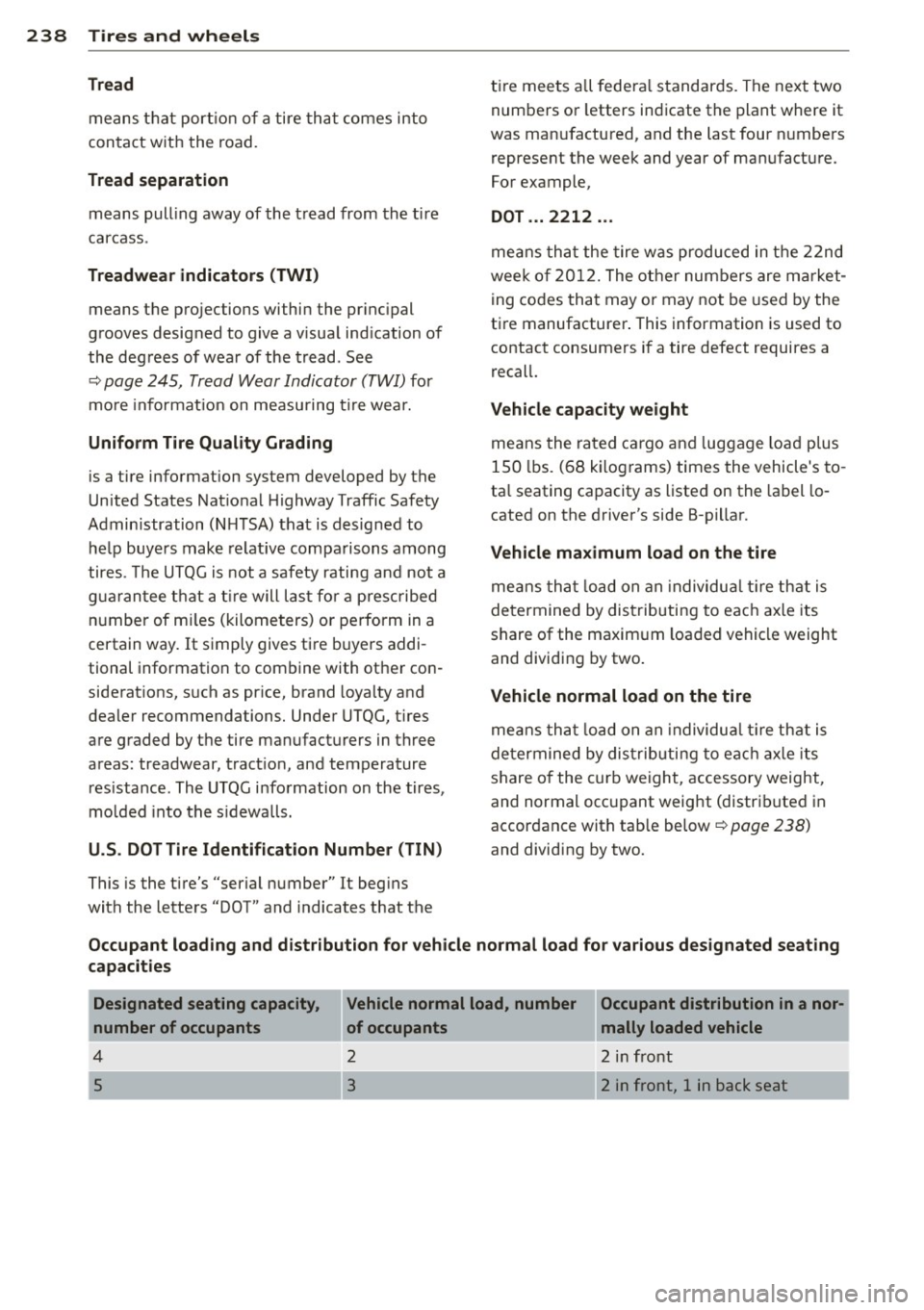
238 Tires and wheels
Tread
means t hat port ion of a tire that comes into
con tact w it h t he road.
Tread separation
means pull ing away of the t read from the ti re
carcass .
Treadwear indicators (TWI)
means the projections within the pr inc ipal
grooves designed to give a v isua l ind ication of
the deg rees of wea r of the tread . See
~ page 245, Tread W ear Indicator (T WI) for
mo re info rmat io n on measu ring ti re wear.
Uniform Tire Quality Grading
is a tire information system developed by the
United States Nat io nal Highway Traffic Safety
Admi nistration (N HTSA) that is designed to
h e lp buye rs make relat ive compa risons among
tires. The UTQG is not a safety rating an d no t a
g ua ran tee t hat a tir e will las t fo r a presc ribed
nu mber of m iles (kilome ters) or perform in a
certain way. It s imply gives tire buye rs addi Ā
tional informat ion to com bine with ot her conĀ
side rat ions, s uch as pr ice, brand loya lty and
dea ler recommendations. Under UTQG, t ires
are g raded by t he tire manufacturers in th ree
areas: treadwear, tract io n, and temperature
res ista nce. Th e UTQG i nfo rmation on the tires ,
mo lded into t he s idewalls.
U.S . DOT Tire Identification Number (TIN)
This is the t ire 's "serial number" It beg ins
with the lette rs "DOT" and indicates that the t
ir e mee ts a ll fede ra l standards. The nex t two
numbe rs o r letters in dicate the plant where it
was man ufactu red, and the last four numbers
represent the wee k and year of man ufact ure.
For example,
DOT . .. 2212 ...
me ans th at the tire w as produced in t he 22nd
wee k of 2012 . T he o the r num bers are m arketĀ
ing co des that may or may not be used by the
t ir e manufacturer . This information is used to
contact consume rs if a tire defect requires a
recall.
Vehicle capacity weight
means the ra ted ca rgo an d luggage lo ad plus
150 lbs. ( 68 kilo gr ams) times the vehicle's to Ā
ta l seating ca pacity as listed on the la bel lo Ā
cated on the driver's side B-pilla r.
Vehicle maximum load on the tire
me ans tha t load on an individu al tire tha t is
de termined by dis tributi ng to eac h axl e its
share of the maxim um loa ded vehicle weight
and dividing by two .
Vehicle normal load on the tire
means th at l oad o n an individua l tire tha t is
de termined by dis trib uti ng to eac h axle its
share o f the cur b weight , accessory weight,
and normal occ upant weig ht (distr ibuted in
accordance with tab le be low ~
page 238)
and dividing by two.
Occupant loading and distribution for veh icle normal lo ad fo r variou s designated seating
capacities
Designated seating capacity,
number of occupants
4
5
Vehicle normal load, number Occupant distribution in a nor-
of occupants _____ malty loaded vehicle
2 2 in front
3 2 in front, 1 i n bac k seat
Page 242 of 300

240 Tires and wheels
change. In the event of discrepancies, the tire
pressure labe l is located on the driver's side BĀ
p ill ar a lways takes precedence.
The table below lis ts the recommended cold
tire inflation pressures for the Audi model covered
by your Owner's Literature at the vehi Ā
cle's capacity weight and the tire sizes instalĀ
l ed on the respective models as orig inal
equipment, or as a factory option.
Tire pressure
Engine Tire designation normal load condition full load condition
fronta> reara>
front rear
AS 4.2 Ii-235/55 Rla 104H XL all
ter season
a -cylinder 255/45 R19 104H XL all
season
265/40 R20 104V XL
IA8 L4.2 Ii-235/55 Rla 104H XL all
ter season
a-cylinder 255/45 R19 104H XL all
season
6.3 liĀ
ter12-cylĀ
inder 265
/40 R20 104V XL
265/40 R20 104V
255/45 R19 104H all sea-
son PSI
35
35
33
35
35
35
36
kPA
240
240
230
240
240
240
250
PSI
32
32
30
32
32
32
32
kPA
220
220
210
220
220
220
220
PSI kPA
36
250
36 250
33 230
36 250
36 250
36 250
39 270
PSI
38
38
35
38
38
35
38
kPA
260
260
240
260
260
240
240
260
I
I
I
XL= reinforced or extra load tire. It may also appear as xl, EXTRA LOAD, or RF on the tire sideĀ
wall.
a l nor mal load co nd it io n"'> page 238 .
The correct tire pressure for the spare wheel is
located on a label on the driver's side B-pillar.
Because technical changes may be made to
vehicle equipment during the model year, a lĀ
ways compare the tire size designation on the
tire pressure label on your vehicle with the
tires on your vehicle. Make sure that the tire
size information on the veh icle label is the
same as the size of the tires on the vehicle.
This is especially important if the vehicle beĀ
l ongs to someone else or you bought the veh iĀ
cle with different rims/tires or you bought the
vehicle as a previously owned vehicle .
Remember, your safety and that of your pasĀ
sengers also depends on mak ing su re that
l oad limits are not exceeded. Vehicle load inĀ
cludes everybody and everything in and on the
vehicle . These load limits are technically refer- red to as the veh
icle's Gross Vehicle Weight
Rat ing ("GVWR"). The Gross Axle Weight RatĀ
ing ("GAWR") is the maximum load that can
be applied at each of the vehicle's two axles .
The Gross Vehicle Weight Rating and the
Gross Axle Weight Rating are listed on the
safety compl iance sticke r label located on the
driver's side B-pillar. The tire pressu re labe l on
your Audi lists the maximum combined
weight of all of the occupants and luggage or
other cargo that the vehicle can carry. For the
location of the tire pressure label
Ā¢ fig. 183.
A WARNING
Overloading a vehicle can cause loss of veĀ
hicle contro l, a crash or other accident, seĀ
rious personal injury, and even death.
- Carrying more we ight than your veh icle
was designed to carry will prevent the
Page 243 of 300
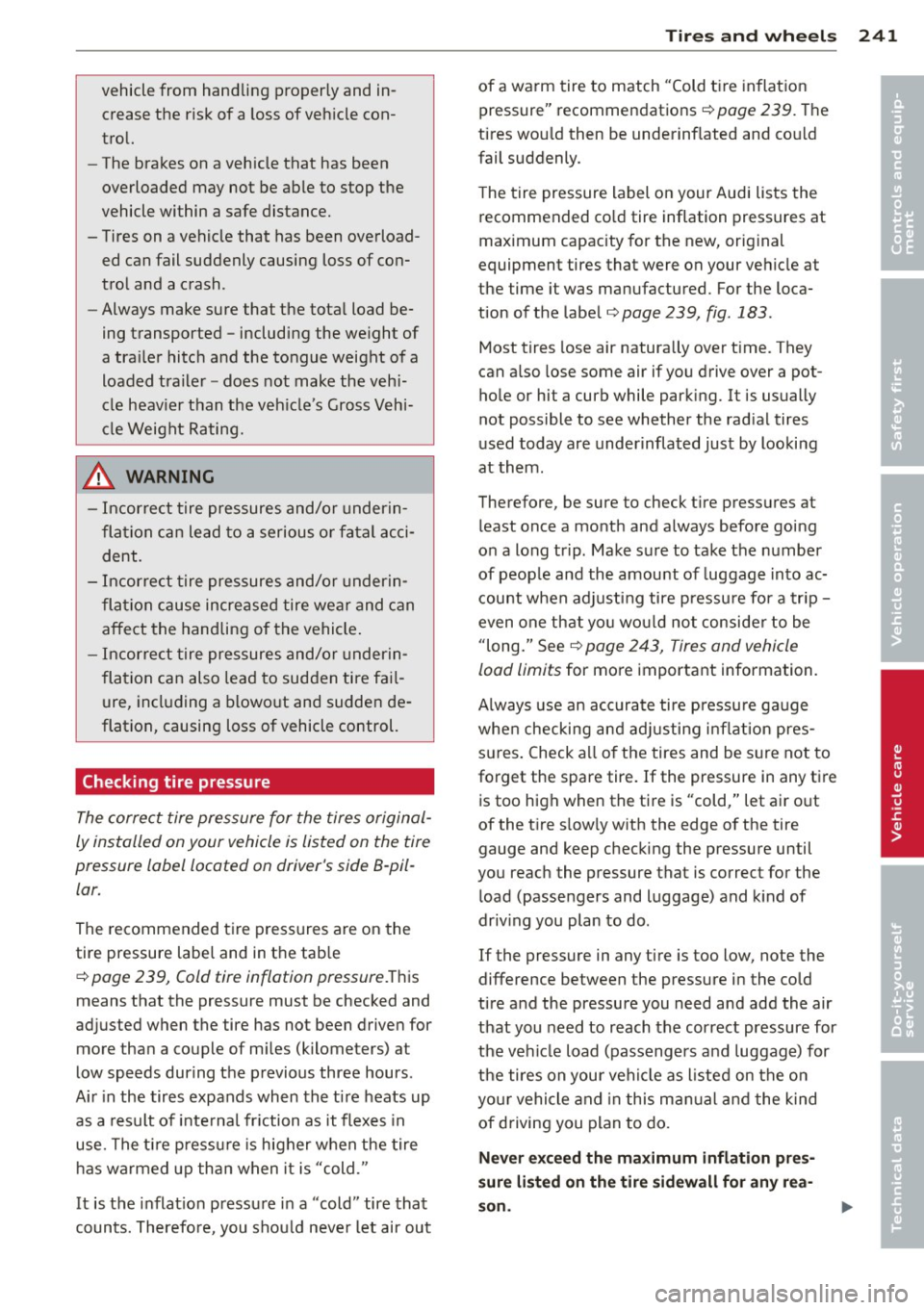
vehicle from handling properly and inĀcrease the risk of a loss of veh icle conĀ
tro l.
- The brakes on a veh icle that has been
overloaded may not be able to stop the
vehicle within a safe distance.
- Tires on a vehicle that has been overloadĀ ed can fail suddenly causing loss of conĀ
tro l and a crash .
- Always make sure that the tota l load beĀ
ing transported -including the we ight of
a tra ile r hitch and the tongue weight of a
loaded trailer -does not make the veh iĀ
cle heav ier than the veh icle's Gross VehiĀ
cle Weight Rating.
A WARNING
- Incorrect tire pressures and/or underinĀ
flation can lead to a serious o r fatal acciĀ
dent.
- Incorrect tire pressures and/or underinĀ
flation cause increased tire wear and can
affect the handling of the vehicle .
- Incorrect tire pressures and/or underinĀ
flation can also lead to sudden tire fa ilĀ
ure, including a blowo ut and sudden deĀ
flation, causing loss of vehicle control.
Checking tire pressure
.
The correct tire pressure for the tires originalĀ
ly installed on your vehicle is listed on the tire
pressure Lobel located on driver's side 8-pilĀ
lor.
The recommended tire pressures are on the
tire pressure labe l and in the tab le
c:> page 239, Cold tire inflation pressure .Th is
means that the pressure must be checked and
adjusted when the tire has not been driven for
more than a couple of m iles (kilometers) at
low speeds during the previous three hours.
Air in the tires expands when the tire heats up
as a result of inte rna l fr iction as it flexes in
use. The ti re p ress ure is higher when the tire
h as warmed up than when it is "cold."
It is the inflat ion pressure in a "cold " tire that
counts. Therefo re, you shou ld neve r let air out
Tire s an d wheel s 241
of a wa rm tire to match "Cold tire inflat ion
pressure" recommendations
c:> page 239. T he
tires wou ld then be underinflated and cou ld
fail suddenly .
T he t ire pressure label on your Audi lists the
recommended co ld tire inflation pressures at
maximum capacity for the new, orig inal
equipment tires that were on your vehicle at
the time it was manufactured. For the locaĀ
tion of the labe l
c:>poge 239, fig . 183 .
Most tires lose air natura lly over t ime. They
can a lso lose some air if you drive over a potĀ
hole or hit a curb while park ing. It is usually
not possible to see whether the rad ia l tires
used today are underinflated just by looking
at them.
Therefore, be sure to check t ire pressures at
least once a mo nth and a lways before going
o n a long tr ip . Make sure to take the number
of peop le and the amount of luggag e into acĀ
count when adjust ing tire p ressu re for a trip -
even one th at yo u wo uld not conside r to be
"long." SeeĀ¢
page 243, Tires and vehicle
load limits
for mo re important information .
Always use an accura te ti re pressu re gauge
whe n checking and adj usting i nflation presĀ
s ur es . Check a ll of the tires and be sure not to
forget the spare tire.
If the pressure in any tire
is too high when the ti re is "cold," let air o ut
of the t ire s low ly w ith the edge of the tire
gauge and keep checking the pressure until
you reach the pressure that is correct for the load (passengers and luggage) and k ind of
driv ing you plan to do .
If the pressure in any tire is too low, note the
difference be tween the pressure in the cold
ti re and the pressure you need and add the air
that you need to reach the correct pressure for
the ve hicle load (passengers and luggage) for
t h e tires on you r veh icle as l isted on the on
you r vehicle and in this ma nual a nd the k ind
of driving you plan to do.
Nev er e xceed the ma ximum inflation pre sĀ
s ure lis te d on the tir e sidewall for any re aĀ
son.
ā¢
ā¢